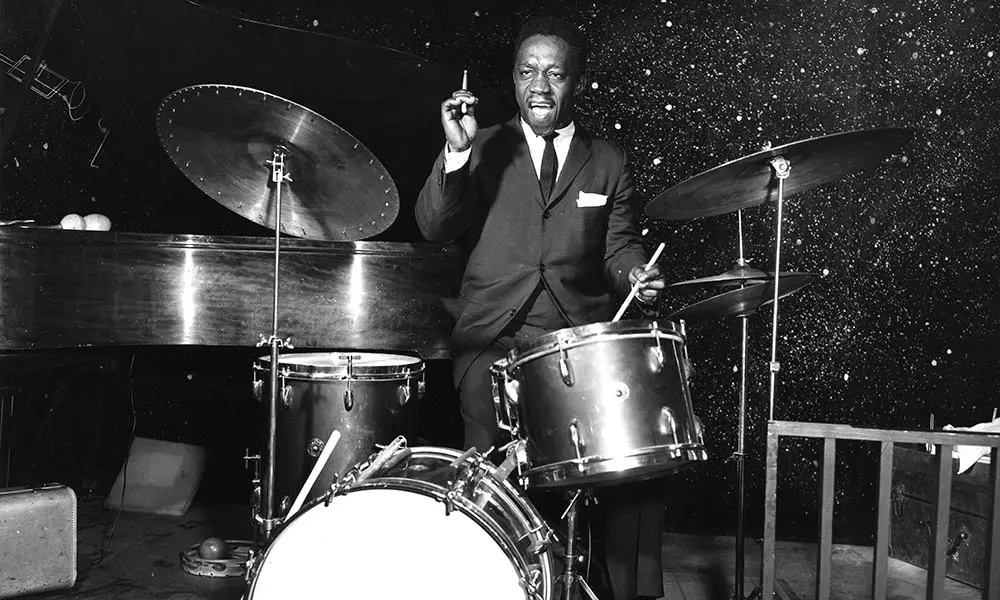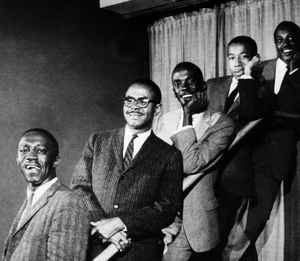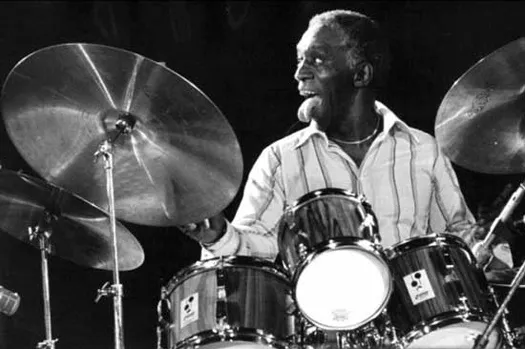
Art Blakey was not just a drummer. He was a force of nature in the world of jazz. He emerged as one of the most influential and dynamic figures in jazz history. Blakey became renowned not only for his extraordinary drumming prowess but also for his leadership in shaping the genre through his influential band, the Jazz Messengers.
Early Life
Born 11 October 1919, Arthur Blakey was born in Pittsburgh, Pennsylvania, US, to a single mother who died shortly after his birth. Blakey was born into a musically inclined family. His uncle, Rubi Blakey, was popular in Pittsburgh as a singer, choral leader, and teacher.
Art Blakey was a self-taught pianist. When he was in the seventh grade, he began taking adult responsibilities by playing piano to earn money and learning to be a band leader.
Career
In the early 1930s, Blakey switched from piano to drums after the club owner ordered him to give way to Erroll Garner. In drums, he was influenced by the aggressive swing style of Chick Webb, Sid Catlett, and Ray Bauduc. And throughout his early career, Art Blakey already played drums for different bands including the twelve-piece band of Mary Lou Williams, the Henderson band, and the Billy Eckstine Orchestra.
Throughout his career, Blakey collaborated with numerous jazz legends including Miles Davis, Dizzy Gillespie, Charlie Parker, Bud Powell, and Thelonious Monk.
The Jazz Messengers
“Yes sir, I’m gonna stay with the youngsters. When these get too old, I’m gonna get some younger ones. Keeps the mind active.“
— Art Blakey, A Night at Birdland, Vol. 2 (CD)

Initially formed as a collective of musicians to accompany pianist Horace Silver, The Jazz Messengers quickly evolved into a standalone ensemble with Blakey at its helm. Throughout its storied history, the lineup of The Jazz Messengers featured some of the most talented and innovative musicians in jazz, including Wayne Shorter, Lee Morgan, Freddie Hubbard, Benny Golson, Bobby Timmons, Cedar Walton, and countless others.
Under Blakey’s leadership, The Jazz Messengers developed a style that critics called hard bop which is a logical progression on the bebop style. It is characterized by its infectious rhythms, soulful melodies, and electrifying improvisations. Blakey’s propulsive drumming style provided the foundation for the group’s dynamic performances, driving the music forward with relentless energy and power.
The Jazz Messengers’ repertoire drew from a variety of influences, including bebop, blues, gospel, and African rhythms, resulting in a sound that was both sophisticated and accessible. Their music was marked by tight arrangements, fiery solos, and a strong sense of collective improvisation, reflecting the camaraderie and chemistry of the band members.
Throughout the 1950s and 1960s, Art Blakey and the Jazz Messengers released a string of acclaimed albums for labels such as Blue Note Records, solidifying their reputation as one of the premier jazz ensembles of their time. Classics like “Moanin’,” “A Night in Tunisia,” and “Free for All” showcased the group’s virtuosity and innovation, earning them a devoted fan base and critical acclaim.
Art Blakey & the Jazz Messengers, Moanin’ Live
Art Blakey & the Jazz Messengers, A Night in Tunisia live
Beyond their recorded output, Art Blakey and the Jazz Messengers were renowned for their electrifying live performances, captivating audiences around the world with their passion, intensity, and improvisational prowess. Their influence extended far beyond the realm of jazz, inspiring generations of musicians and leaving an indelible mark on the history of music.
Although the lineup of The Jazz Messengers changed frequently over the years as members pursued their own solo careers or formed their own bands, Art Blakey remained a constant presence at the group’s core, serving as both its driving force and its spiritual leader. His commitment to nurturing young talent and preserving the legacy of jazz ensured that The Jazz Messengers would continue to thrive long after his passing in 1990.
Drumming Style
Art Blakey has a unique element such as unmatchable driving rhythms and high hat two and four beats. He was one of the first drummers to master a polyrhythmic drumming style. He used a traditional grip but in later appearances, he was seen using a matched grip.
Here is a 1973 drum duo between Art Blakey and Ginger Baker where he can be seen repeatedly changing grips during the performance.
Art Blakey and Ginger Baker drum duet
Art Blakey passed away on 16 October 1990 at the age of 71. His cause of death was lung cancer. Throughout his illustrious career, Blakey received numerous accolades and awards, including multiple Grammy nominations and induction into the DownBeat Hall of Fame. His influence on jazz drumming and his contributions to the genre as a whole continue to resonate with musicians and fans alike, ensuring his enduring legacy in the annals of jazz history.
Here are more of Art Blakey:
The Grooves of Art Blakey by Drumeo
The Genius of Art Blakey by Drumeo
Here’s a Drum Solo in No Problem
If you feel like tapping your feet, tap your feet. If you feel like clapping your hands, clap your hands. And if you feel like taking off your shoes, take off your shoes. We are here to have a ball. So we want you to leave your worldly troubles outside and come in here and swing.” – Art Blakey


